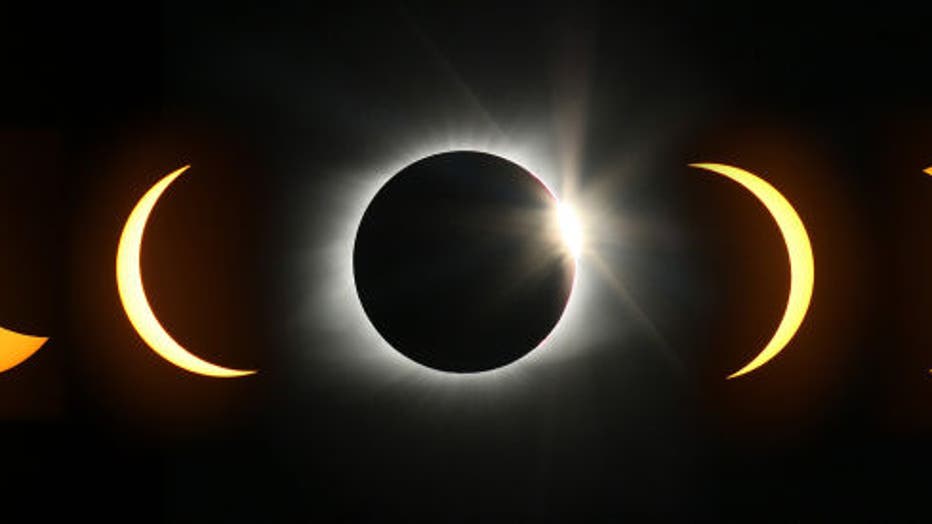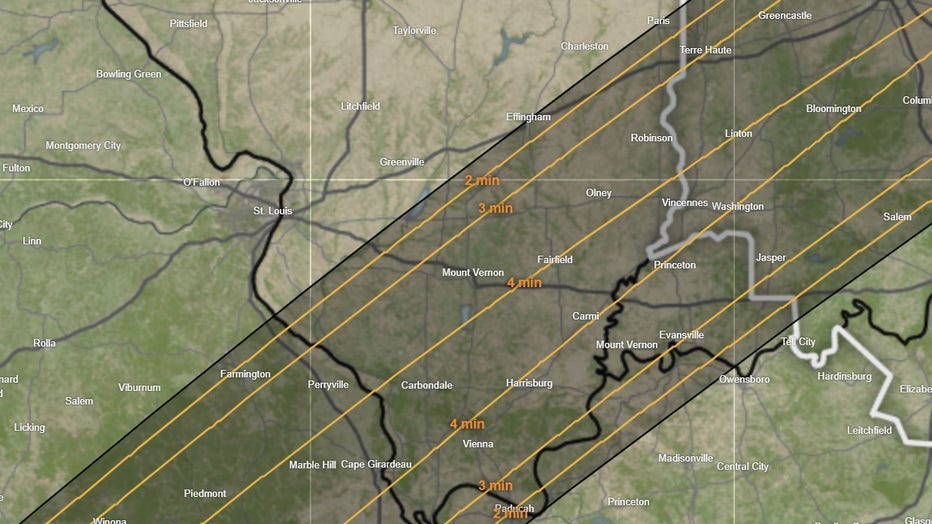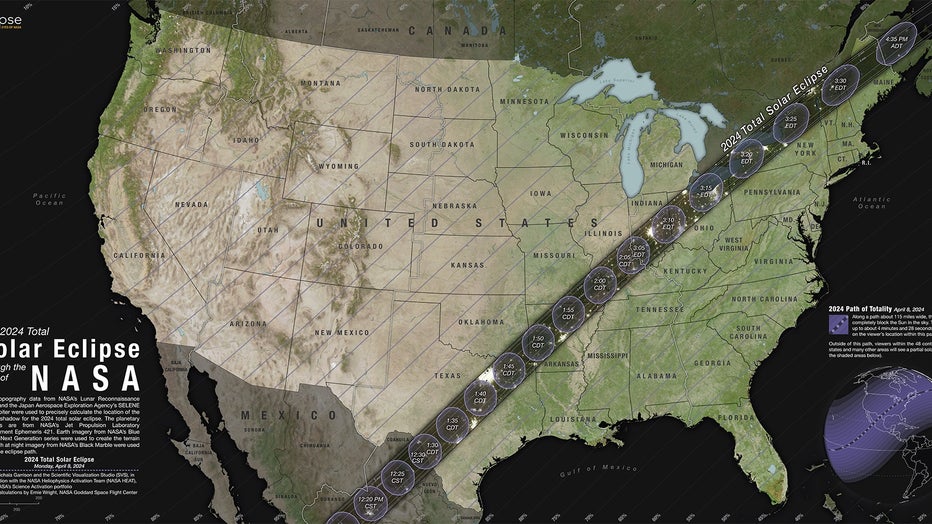Track the solar eclipse as it moves over Chicago, Illinois and Indiana

People gather along path of totality to see eclipse
It was a great day in Chicago and across the U.S. for eclipse enthusiasts!
CHICAGO - It's finally April 8, which means it's time to don those protective glasses as the 2024 solar eclipse moves over a large swath of the United States, including Chicago, southern Illinois and Indiana.
While Chicago won't be in the path of totality, the eclipse is expected to offer a breathtaking show in the city. Chicago and the surrounding suburbs will experience a partial eclipse, with an estimated 94% totality.
Meanwhile, in southern Illinois, numerous cities and towns will lie in the path of totality.
RELATED: PEAK VIEWING TIMES IN ILLINOIS
The eclipse's trajectory, moving from southwest to northeast, will encompass cities like Cairo, Olive Branch, Grand Tower, Red Bud, Carbondale, Mount Vernon, Harrisburg, and Fairfield before reaching communities near the Indiana border such as Olney and Robinson. They all lie in the path of totality and will be plunged into darkness for up to a few minutes.
Peak totality for Chicago will occur around 2:07 p.m., while in southern Illinois it will begin around 1:58 p.m. In Indianapolis, peak totality will take place at 3:06 p.m. local time.
Stay with FOX 32 Chicago on Monday for live updates as the solar eclipse puts on a show for most of the country. Follow our live blog below for the latest news, photos and videos. Mobile users click HERE.
What is a Total Solar Eclipse?
A total solar eclipse occurs when the Moon passes between the Sun and the Earth, completely obscuring the Sun's face for several minutes. The process, from partial eclipse through totality, spans several hours and features phenomena such as Baily's Beads and the Diamond Ring caused by the Moon's pockmarked surface.

Tips for viewing the last total solar eclipse for 20 years
Mother Nature is putting together quite a show for all to see on April 8. It?s going to be the last total solar eclipse that we will see for the next 20 years and Illinois has some of the best seats to offer.
What does Totality mean?
Totality in an eclipse is when the moon fully obscures the sun, allowing observers within the path of the moon's shadow to witness it. When totality occurs, the corona (the sun's outer atmosphere) becomes visible as a halo surrounding the moon. The day is plunged into twilight, stars and planets may become visible in the sky, and the temperature drops as much as 10 degrees. This period of totality is typically quite short – a few minutes, tops – but it can have a profound impact on those who experience it.

A composite image of eight pictures shows the phases of the total eclipse as the moon passes from left to right in front of the sun during a solar eclipse on Monday, Aug. 21, 2017, near Perryville, Mo. Shot with an equivalent of an 800mm lens, the pa
What Will I See During the Eclipse?
If you are in the path of totality:
The moon will appear to completely block the sun for as long as seven and a half minutes. Daytime will turn into near night during that time and the sun’s corona – the outer rays – may be visible.
If you are not far from the path of totality:
The moon will appear to block most of the sun. It will still become noticeably darker; daylight will become more like twilight.
If you are well outside the path of totality:
You’ll notice a chunk of the sun is being blocked. The farther away you are, the smaller the moon’s bite will appear to be. In Seattle and Portland, Oregon, about as far away as you can get in the continental U.S., one-third of the sun will be swallowed.

The length of totality in southern Illinois is shown in orange | NASA
Where Can I Get Eclipse Glasses?
Solar eclipse glasses are essential if you want to look at the eclipse itself. Even with the moon partially blocking it, the sun will still be strong enough to damage your eyes.
Many businesses are giving away glasses for free; you can find a list HERE.
If you can’t get eclipse glasses, welder’s glasses can work but only if they are rated with the darkest shade level of 14.
An eclipse viewing box, which projects a shadow of the eclipse, may be a safer option for young children. Here’s how to make one.
How to Know if Your Eclipse Glasses are Safe
Solar filters are used in eclipse glasses and handheld viewers and meet a very specific worldwide standard known as ISO 12312-2.
For a list of verified eclipse glasses and viewers, click HERE.

Solar eclipse countdown underway across the country
More than 31 million people, from Texas to Maine, will be in a prime location to witness a total solar eclipse. In Chicago, we'll still be able to see a partial eclipse. The eclipse will occur at different times in each state on Monday.
Protecting Pets during the Eclipse
While we all need to protect our eyes with a pair of glasses, what about our pets? They'll need to be protected as well. But doctors say: don't try to put glasses on your cat or dog. The best advice is to just bring them indoors and keep them away from windows. Looking at the sun without those special glasses, for even a short time, can cause permanent damage for humans and our pets.
Where else will the total solar eclipse occur?
According to Eclipse2024.org, the unincorporated village of Eidson Road, near the U.S.-Mexico border will be the first to see the phenomenon. Here's the timing of each state's total solar eclipse:
- Dallas, Texas around 1:40 p.m. (CDT)
- Idabel, Oklahoma around 1:45 p.m. (CDT)
- Little Rock, Arkansas around 1:51 p.m. (CDT)
- Poplar Bluff, Missouri around 1:56 p.m. (CDT)
- Carbondale, Illinois at 1:59 p.m. (CDT)
- Paducah, Kentucky around 2 p.m. (CDT)
- Evansville, Indiana at 2:02 p.m. (CDT)
- Cleveland, Ohio at 3:13 p.m. (EDT)
- Erie, Pennsylvania at 3:16 p.m. (EDT)
- Buffalo, New York at 3:18 p.m. (EDT)
- Burlington, Vermont at 3:26 p.m. (EDT)
- Lancaster, New Hampshire at 3:27 p.m. (EDT)
- Caribou, Maine at 3:32 p.m. (EDT)

Path of solar eclipse | NASA
Future Total Solar Eclipses
Following the April 8, 2024, event, the next total solar eclipse in parts of the U.S. won't occur until 2044. Subsequently, an eclipse in August 2045 will cover a more extensive portion of the U.S.


